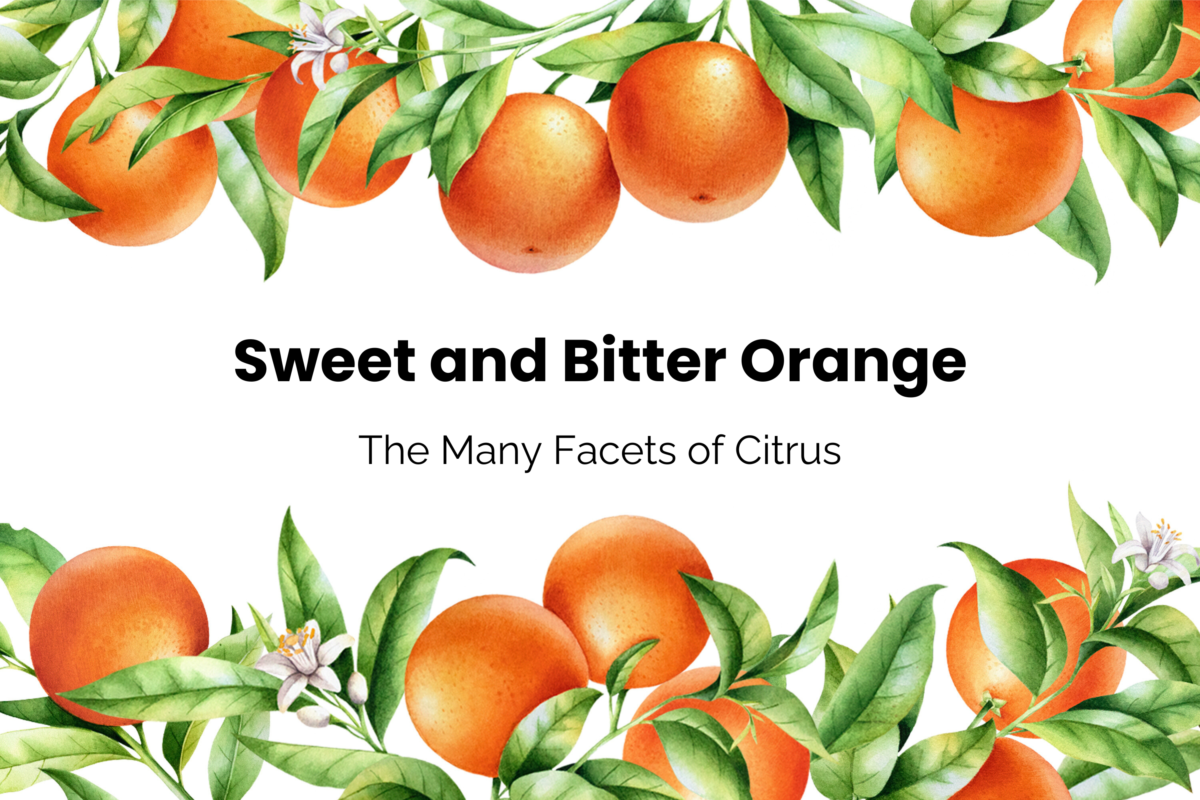Botanical Names: Citrus sinensis, C. aurantium and C. reticulata
Common Names: Orange, Seville orange, bitter orange, sweet orange, sour orange, tangerine, mandarin, naranj (Arabic), chen pi (Mandarin for aged fruit), qing pi (Mandarin for immature peel), zhi si (Mandarin for immature fruit, neratzi (Greek for bitter orange), portokali (Greek for sweet orange), nagaranga (Sanskrit)
Family Name: Rutaceae
DESCRIPTION
Parts Used: The unripe, ripe, and mature peel (pericarp), flowers, and pulp. Essential oils are made with ripe peel, flowers, twigs, and leaves.
Botanical Description and Habitat: Citrus is a genus of evergreen trees and shrubs native to Southeast Asia. Most species are domesticated and only known in cultivation. (1) The plants have smooth, grayish-brown bark. Many species have spines at the axils of alternate leaves. These shiny leaves have a leathery texture, and usually feature wide, winged petioles with wavy margins. (1,2) The sweetly fragrant flowers are solitary or axillary racemes, or clusters. (1,2) Inside the flower is a cup-shaped calyx with three to five lobes and (usually) four or five white petals. (1) Orange flowers have 16-80 stamens and a prominent stigma atop an ovary consisting of 5-14 chambers. (1,2) The distinctive fruit is a specialized berry known as a hesperidium, and can be globose, oblong, or oblate. (1) The rind can be loosely or tightly appressed to the segments, and is covered in essential oil glands. Many seeds are embedded in each pulpy segment. (1)
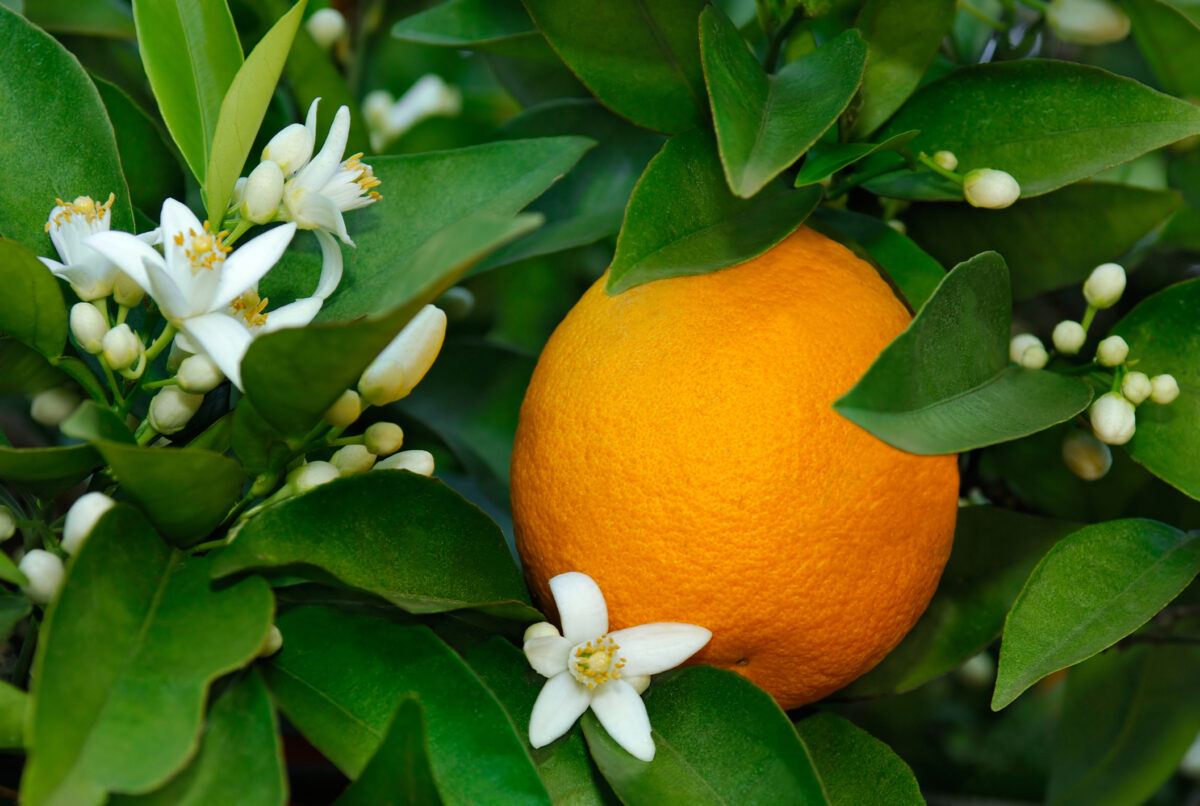
Recent molecular studies suggest that of all the Citrus species, only mandarins (C. reticulata), pomelo (C. maxima), and citron (C. medica) are considered true species; the rest are naturally occurring hybrids or artificially created hybrids of those three species. (3)
Sweet orange (C. sinensis) likely originated in Asia, near the border of China and Vietnam. In the U.S., it is commercially cultivated in Florida, southern California, and Texas. It is also cultivated in Sicily, Cyprus, Guinea, Spain, Israel, and Brazil, among other countries. There are numerous varietals of sweet orange, including navel, Jaffa, and Valencia. Sweet orange trees grow up to 10 meters tall, and bear a few slender spines. (4) Fragrant ovate leaves (7.5-11 cm long) are attached to the stems via narrowly winged petioles. (4) The clusters of flowers are borne in leaf axils. (4) They contain 20 stamens, and produce an oblate fruit (6-9 cm diameter) with a yellow to orange-red rind, and yellow-orange to reddish sweet flesh. (4)
Bitter orange (C. aurantium) is native to southern China and northeast India. It is a small tree (7 to 8 meters tall) cultivated in China, Spain, Italy, Guinea, Brazil, the West Indies, and the U.S. (5) Bitter orange branches have many long, sharp, axillary spines (up to 8 cm long). (5) The flowers have 20-24 fused stamens. (5) Bitter orange globe-shaped fruit (7.5 cm diameter) has a rougher peel than sweet orange. Bitter orange pulp is very bitter and sour.
Mandarin (C. reticulata) is a small tree (4-6 meters tall) with only a few or no spines. (6,7) The lanceolate to ovate leaves (6-8 cm long) have serrate margins. (7) One to three flowers grow per cluster, bearing 20-25 fused stamens and a long, thin style. (6) The fruit rind is pale yellow to scarlet and loosely attached to the inner flesh, which is plump with sweet to acidic juice. (6)
The Name: Derived from Latin, the word Citrus (“citron tree”) is named after the African tree with aromatic wood and lemon-like fruit. The citron tree provided the first citrus fruit in Western Europe. The epithet sinensis refers to the plant’s origin in China. The epithet bigaradia refers to France’s Bigerade region where bitter orange was extensively cultivated. Reticulata derives from the Latin reticularis (“little net”). (8) The common name orange derives from nagaranga (Sanskrit) and naranj (Arabic). (9)
Citrus sinensis is the Latin binomial for the sweet orange cultivated for eating. C. aurantium is known as bitter orange; the fruit is not consumed fresh - it is prepared in marmalade. The flowers from this species yield neroli oil; the twigs yield petitgrain oil. Citrus reticulata is the binomial for mandarin or tangerine orange.
Historical Uses: Arab traders introduced the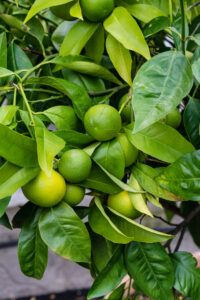 Asian bitter orange tree to Europe. Arab physician Avicenna described the uses of bitter orange juice in the 10th century. (10) The first shipment of bitter oranges reached England on a Spanish ship in 1290. (10) Europeans began drinking the juice to quench thirst, especially resulting from fevers and inflammatory conditions. The peel was used to treat digestive disorders and malaria. As a gift to their prime minister, Portuguese sailors introduced the first sweet orange tree to Europe in the 15th century. (10) Spanish explorers transported the first orange trees to Florida in the 16th century, and Spanish missionaries brought them to California in the 18th century. (11)
Asian bitter orange tree to Europe. Arab physician Avicenna described the uses of bitter orange juice in the 10th century. (10) The first shipment of bitter oranges reached England on a Spanish ship in 1290. (10) Europeans began drinking the juice to quench thirst, especially resulting from fevers and inflammatory conditions. The peel was used to treat digestive disorders and malaria. As a gift to their prime minister, Portuguese sailors introduced the first sweet orange tree to Europe in the 15th century. (10) Spanish explorers transported the first orange trees to Florida in the 16th century, and Spanish missionaries brought them to California in the 18th century. (11)
The oldest reference to oranges appeared in the second book of The Five Classics in China in 500 BCE. (11) Approximately 2,000 years ago, the uses of citrus peels (zhu pi) were first mentioned in the Shen Nong Ben Cao Jing. In 1178 CE, a monograph describing the uses of citruses was published in China. (12) Dried bitter and sweet orange peels were used as carminatives for dyspepsia and to improve the appetite. They continue to be used in Traditional Chinese Medicine to reduce phlegm related to coughs, colds, or flu, to strengthen the spleen, and regulate energy. They are also administered to treat vomiting, diarrhea, blood in feces, and uterine or rectal prolapse. (13)
The antiscorbutic actions of oranges were known several centuries earlier than the discovery of their vitamin C content in the 20th century. Many British sailors died from scurvy on long voyages without access to fresh food. In the 18th century, British naval surgeon James Lind began prescribing citrus fruits to curb scurvy, and British sailors became known as “limeys.” (10)
Oranges have long been used in cooking, food products, perfumes, and medicines. Orange peel syrup and elixir are flavoring agents in medicines. Orange peel and flower syrup enhance the flavor of compounds, and are added to sedative formulas. A hot infusion of bitter orange tea is used as a mild sedative, and can be combined with other sedative herbs. In Europe, an evening sedative consisted of a cup of bitter orange tea with up to one teaspoon of valerian extract. (14) Orange-flavored wine was combined with the intoxicating drink absinthium to mitigate the bitter flavor. (9)

Orange flowers have adorned brides and bridal bouquets throughout southern Europe. Orange blossoms were candied in Grasse, France. Orange flower water is used by French biscuit makers for added crispness. Essential oil of orange blossoms (neroli) is a primary ingredient in eau-de-cologne, the classic toilet water that also includes essential oils of lavender, bergamot, lemon, and rosemary. (9,15)
Bitter orange fruit has been used historically for many culinary applications, and is still used today in the following preparations. Bitter orange fruit is an ingredient in marmalade. Bitter orange zest (or essential oil) is used as a flavoring agent in triple sec, Grand Marnier, Cointreau, and other liqueurs. The immature fruit of bitter orange (orange berries) is used to flavor Curacao. (9) Bitter orange essential oil is used as a flavoring in non-alcoholic beverages, candy, baked goods, gelatins, puddings, meat products, frozen dairy desserts, condiments, and relishes. (13) Sweet orange essential oil is used in food products such as jams, jellies, gravies, sweet sauces, breakfast cereals, and processed vegetables. Essential oils of bitter and sweet orange, neroli, and petitgrain are used as fragrances in lotions, creams, cosmetics, soaps, detergents, and cleaning products. (13)
CONSTITUENTS
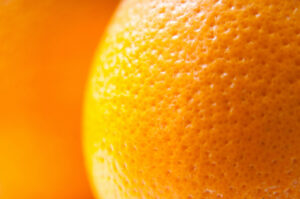
Sweet Orange Peel: Sweet orange peelcontains volatile oil (refer to constituents of the essential oil, below), flavonoids (neohesperidin, hesperidin, naringin, tangeretin, auranetin, and nobiletin), vitamins (B1, C, and E), limonin, coumarins (6, 7-dimethoxycoumarin), carotenoids, pectin, citrantin, and constituents similar to bitter orange peel. (13,16)
Sweet Orange Essential Oil: Sweet orange volatile oil is similar to bitter orange oil (refer to the following paragraph). It contains similar monoterpenes, alcohols, aldehydes (mostly decanal and octanal), ketones, free acids, and esters. Cold-pressed orange oil also contains coumarins (bergaptene and auaptenol), valencene, and α-ylangene. (13)
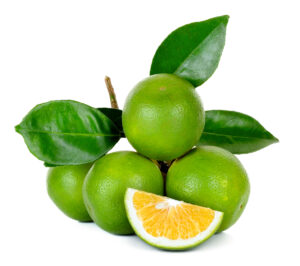
Bitter Orange Peel: Bitter orange peel contains volatile oil (refer to constituents of the essential oil, below), flavonoids (neohesperidin, hesperidin, naringin, rhoifolin, lonicerin, tangeretin, nobiletin, sinensetin, auranetin, and rutin), vitamins (A, B1, and C), coumarins (6,7-dimethoxycoumarin and umbelliferone), carotenoid pigments (citraurin, violaxanthin, and cryptoxanthin), pectin, citrantin, and others. The white part of the peel contains limonoid-type triterpenes and flavonoids (hesperidin, nargingin, and neohesperidin). (13,16)
Bitter Orange Essential Oil: The volatile oil of bitter orange contains monoterpenes (d-limonene, myrcene, camphene, pinene, ocimene, and pcymene), small amounts of alcohols (linalool, terpineol, nerol, farnesol, nerolidol, and octanol), aldehydes (decanal, nonanal, dodecanal, citronellal, neral, acetaldehyde, and formaldehyde), ketones (carvone, α-ionine, and jasmone), free acids (octadecadienoic, pelargonic, cinnamic, and acetic), esters (linalyl acetate, decyl pelargonate, octylacetate, and geranyl acetate), coumarins (osthole and auraptenol), and others. (13)
Neroli (Orange Flower) Essential Oil: Neroli oil contains linalool, linalyl acetate, limonene, β-pinene, nerolidol, geraniol, nerol, methyl anthranilate, indole, jasmone, citral, nonanal, cis-8-heptadecene, 2,5-dimethyl-2-vinyl-4-hexenal, neryl acetate, valeric acid, and others. (13)
Petitgrain Essential Oil: Petitgrain oil contains esters (linalyl acetate and geranyl acetate), linalool, nerol, α-terpineol, geraniol, nerolidol, farnesol, and limonene. (13)
Nutritional Properties: Orange peel contains flavonoids, carotenoids, and vitamins B1, C, and E. (13)
MEDICINAL USES
Medicinal Properties: Anti-nauseant, astringent, bitter tonic, carminative, circulatory stimulant, cholagogue, detoxifier, expectorant, and stomachic.
Energetic Properties: Warm, pungent, bitter, sweet, and astringent.
Ripe Orange Peel
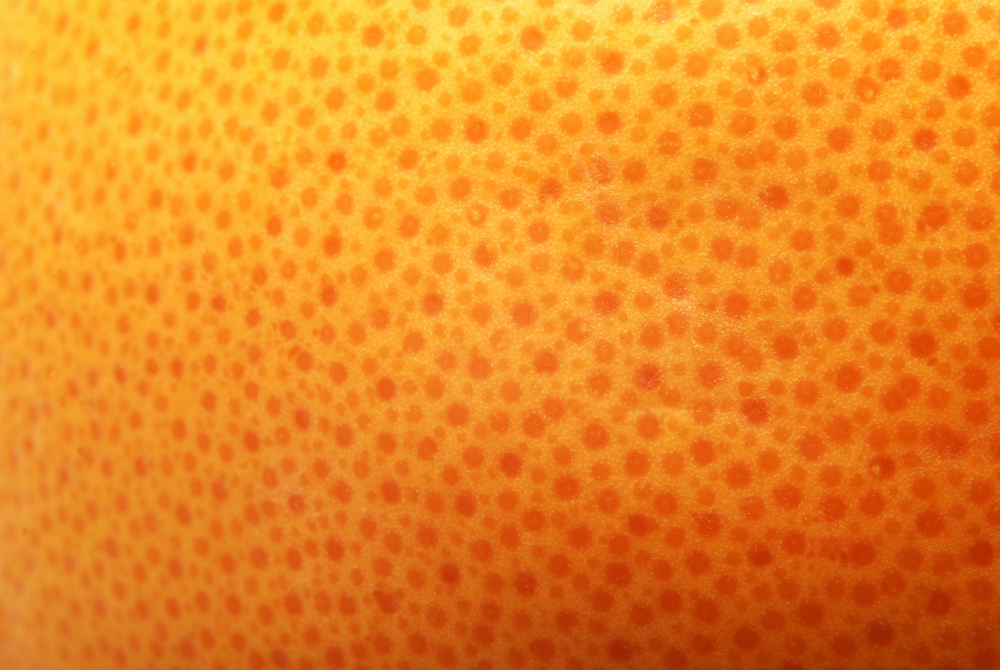
Enhances Digestion
The ripe peel of sweet and bitter orange enhance digestion due to their carminative, cholagogue, and bitter tonic properties. The peel contains two intensely bitter flavonoid glycosides, naringin and neohesperidin. Orange peel stimulates digestive secretions, and can be used to treat appetite loss. It reduces a sense of fullness, belching, hiccoughs, dyspepsia, gas, and bloating. The volatile oil in the peel reduces nausea and vomiting. Orange peel increases circulation, especially in the digestive tract. It is often combined with other bitterand carminative herbs in digestive bitter tonic compounds and cordials, including bitter herbs such as artichoke leaf (Cynara), gentian (Gentiana), or berberis (Berberis), and carminative herbs such as cardamom (Elettaria), coriander (Coriandrum), fennel (Foeniculum), and ginger (Zingiber). According to Traditional Chinese Medicine, orange peel warms the spleen, enhances digestion, and regulates the middle burner. It is combined with qi tonifying herbs such as ginseng (Panax ginseng), Codonopsis, or Astragalus to reduce qi stagnation.
Respiratory Decongestant and Expectorant
An expectorant, orange peel thins and expels mucus, and reduces copious watery phlegm. It is beneficial for treating moist lung conditions, including asthma, chronic bronchitis, a productive cough, or a cold. The volatile oil has antiseptic and lymphatic actions. The flavonoids and pectin are antibacterial and antifungal. Orange peel astringes mucous membranes, especially in the respiratory and digestive tracts. The astringent actions aid in treating loose stools and diarrhea.
According to Traditional Chinese Medicine, orange peel dries and disperses dampness in the chest and abdomen.
Rich in Vitamin C and Flavonoids
Orange peel, pulp, and juice provide an excellent source of vitamin C and flavonoids that synergize the vitamin’s effects. The vitamin C content reduces inflammation, enhances the integrity of connective tissue, and counters the body’s response to stress. Vitamin C and flavonoids inhibit the release of histamines that are highly beneficial in reducing allergies and allergy-related asthma attacks, wheezing, respiratory infections, and nasal congestion. Vitamin C and flavonoids are antioxidants that inhibit free radical formation, supporting the cardiovascular and immune systems. They enhance the integrity of the vascular system, and can be used as a daily tonic to reduce capillary fragility and permeability. Orange peel also can be used for the long-term treatment of varicose veins, degenerative vascular diseases such as atherosclerosis and hypertension, and diabetes. It facilitates the healing of bruises and wounds.
Gentle Detoxifier
Orange peel enhances detoxification. It contains pectin which is highly ionic, drawing from the tissues and binding with environmental toxins and heavy metals. The pectin and cholagogue actions also help to lower cholesterol.
Unripe Citrus Peel (Green Tangerine, Qing Pi)
A Liver Decongestant
 The green peel from the immature fruit of C. reticulata (syn. C. reticulata viride) is known as green tangerine, blue citrus, or qing pi. Green tangerine peel has the same actions as orange peel in the digestive, respiratory, and cardiovascular systems, and in its energetic properties (warm, bitter, and acrid). However, it is used specifically in Traditional Chinese Medicine as a liver decongestant. It encourages the smooth flow of liver qi and breaks up qi stagnation, treating symptoms such as distension and pain in the chest, breast, or hypochondriac regions. It alleviates food stagnation, easing abdominal pain and distension. It is often combined with chai hu (Bupleurum) and yu jin (Curcuma) for pain and distension in the chest and flanks due to liver and stomach disharmonies. It is combined with xiang fu (Cyperus) for chest and flank pain associated with liver qi stagnation. (17)
The green peel from the immature fruit of C. reticulata (syn. C. reticulata viride) is known as green tangerine, blue citrus, or qing pi. Green tangerine peel has the same actions as orange peel in the digestive, respiratory, and cardiovascular systems, and in its energetic properties (warm, bitter, and acrid). However, it is used specifically in Traditional Chinese Medicine as a liver decongestant. It encourages the smooth flow of liver qi and breaks up qi stagnation, treating symptoms such as distension and pain in the chest, breast, or hypochondriac regions. It alleviates food stagnation, easing abdominal pain and distension. It is often combined with chai hu (Bupleurum) and yu jin (Curcuma) for pain and distension in the chest and flanks due to liver and stomach disharmonies. It is combined with xiang fu (Cyperus) for chest and flank pain associated with liver qi stagnation. (17)
Immature Fruit of Bitter Orange (Zhi Shi) 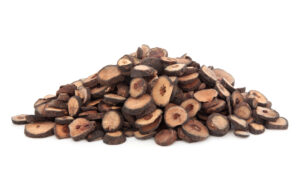
A Gentle Laxative
The immature fruit of bitter orange (C. aurantium) is known as zhi shi (Chinese), kijitsu (Japanese), or chisel (Korean). While it shares some energetic properties of other citrus peels (bitter and acrid), it is also slightly cooling. Zhi shi shares the same expectorant, bitter, carminative, and laxative actions, but is most specific to direct qi downward, unblocking the bowels and treating abdominal pain, constipation, and dysenteric diarrhea. (17) Small doses relax the intestines; large doses increase peristalsis. Zhi shi is a carminative that reduces food stagnation, indigestion, gas, and bloating. (17) It can be combined with other qi tonifying herbs to treat organ prolapse. It is used to treat prolapsed hollow organs such as the uterus, rectum, or stomach. Zhi shi also prevents qi stagnation when combined with qi tonifying herbs. It has expectorant actions and reduces sensations of fullness in the chest. (17) It is contraindicated during pregnancy, or in individuals with deficient qi or cold in the stomach due to deficiency. (17)
Aged Citrus Peel (Chen Pi) 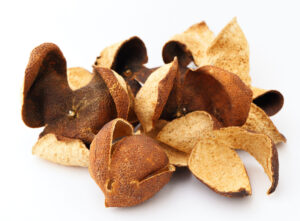
Aged or mature tangerine peel (C. reticulata) is known as chen pi (Chinese), or “aged peel.” Additional names include chinpi (Japanese) and chinp’i (Korean). Western herbalists prefer the fresh aromatic qualities of recently dried citrus peel; aged citrus peel is equally valued in Traditional Chinese Medicine. The energetic properties are warm, bitter, acrid, and aromatic.
Enhances Digestion
Like ripe citrus peel, chen pi is used for the digestive and respiratory systems, and to regulate qi. (17) It warms the spleen and regulates the middle burner. Chen pi is a carminative; it reduces a sense of fullness, belching, hiccoughs, gas, bloating, nausea, and vomiting. (17) It enhances spleen transforming and transporting functions, improving digestion and assimilation. It also can be used to treat a loss of appetite. Chen pi reduces potential stagnation that can result from tonifying herbs, and is often used in combination with qi tonifying herbs. It dries and disperses dampness in the chest or abdomen, reducing phlegm in the lungs and treating loose stools. (17) It is contraindicated for hot conditions, including a red tongue, yellow or orange phlegm, dry cough, or spitting of blood. (17)
The Pulp
The fleshy part of orange fruit can be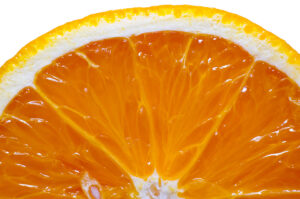 consumed raw or juiced. It contains vitamin C and flavonoids. For more information on vitamin C and flavonoids, refer to the second to last paragraph in the section on the ripe peel. Orange also contains several B vitamins (B1, B2, B6, folic acid, and pantothenic acid), carotenes, pectin, and potassium. The fruit is a good source of fiber, and is hydrating on hot days. (14) The sour flavor of the fruit, especially with the pith, stimulates digestion, and is a natural bile stimulant and mild laxative.
consumed raw or juiced. It contains vitamin C and flavonoids. For more information on vitamin C and flavonoids, refer to the second to last paragraph in the section on the ripe peel. Orange also contains several B vitamins (B1, B2, B6, folic acid, and pantothenic acid), carotenes, pectin, and potassium. The fruit is a good source of fiber, and is hydrating on hot days. (14) The sour flavor of the fruit, especially with the pith, stimulates digestion, and is a natural bile stimulant and mild laxative.
Neroli - Bitter Orange Flowers
Bitter orange flowers are consumed primarily in tea, syrup, or honey. They have calming effects, and can be used to treat nervousness, anxiety, and insomnia. They are also added to cordials and elixirs as an aphrodisiac, and are employed as a harmonizer.
Citrus Essential Oil
Varied essential oils are produced from the different species of orange and numerous parts of the plants.
Orange Flower, Neroli (Citrus aurantium var. amara)
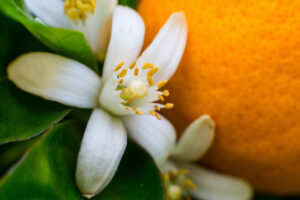
Neroli was named in honor of Anne-Marie, the 16th century princess of Nerola who loved the scent. She used neroli to perfume her gloves and bath water. Her glove perfume became so popular, it was known as guanti di Neroli. (15) The white flowers of bitter orange (C. aurantium var. amara) are used to produce the exotic, prized essential oil of neroli. Bitter orange spring flowers are considered superior to fall and sweet orange flowers. The aqueous byproduct of distillation is called orange flower hydrosol, or orange flower water. Three methods used to extract the essential oil are distillation, concrete, and absolute.
Neroli has calming and mildly sedating actions. (18) The essential oil and hydrosol are used to treat anxiety, insomnia, nervous tension, and shock. (12) Neroli decreases the amplitude of heart muscle contraction, and is beneficial for alleviating palpitations, cardiac spasms, and anxiety attacks. It is an antidepressant and mood elevator. (12,18) Neroli oil and hydrosol have aphrodisiac actions and can be used as perfume. Blending neroli with sandalwood, rose, and jasmine essential oil produces an exotic perfume. Neroli is beneficial for all skin types, and can be added to facial serums, creams, and lotions. It stimulates cellular regeneration in skin, and reduces irritation, relieving redness, broken skin and veins, and couperose skin. (12) Orange hydrosol soothes the digestive tract, acting as a carminative and stomachic. It is useful for treating infant colic and as a sedative for children. There are no known contraindications with the physiological dosage. (18)
Directions: Apply one to two drops of neroli essential oil topically (neat or diluted) or add to a diffuser. Orange flower hydrosol can be consumed internally (one teaspoon, up to five times daily) or applied topically.
Petitgrain (Citrus aurantium var. amara)
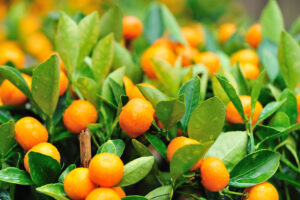
The name petitgrain means “little fruit,” and originated from essential oil produced from the unripe, small fruit. (12) A distillation of twigs and young shoots of bitter orange (C. aurantium var. amara) is used to produce petitgrain essential oil. Benjamin Balansa, 19th century French botanist, first distilled the leaves. (12) Petitgrain has a distinctly bitter, earthy aroma. It has antidepressant and anxiolytic actions. It can be used to decrease anxiety, nervousness, insomnia, and depression, as well as stabilizing the nervous system. (18) Aromatherapist Kathy Keville recommends using petitgrain to increase perception and awareness, and reestablish trust and self-confidence. (12) Petitgrain combines well with other sweet-smelling essential oils such as ylang ylang or palmarosa. An excellent lip balm contains small amounts of palmarosa, a citrus peel oil such as orange, grapefruit or bergamot, and one or two drops of petitgrain. There are no known contraindications with the physiological dosage.
Directions: Apply 1-2 drops topically (neat or diluted), or place 1-3 drops in the diffuser.
Sweet Orange (Citrus sinensis) and Bitter Orange (Citrus aurantium)
The essential oils of sweet and bitter orange are commonly prepared by cold-pressing the peel. However, essential oil of fresh orange peel (from expressed or unexpressed fruits) is also steam distilled or distilled from byproducts in the manufacture of orange juice concentrates. The latter preparation produces oils inferior to the other methods. Terpene-less orange oils (bitter and sweet) are obtained from vacuum distillation or extraction with dilute ethyl alcohol. Only organic or biodynamic sources of orange essential oil should be used therapeutically because orange peels are heavily sprayed, and contain the concentrated chemical residue of pesticides and herbicides.
Sweet and bitter orange peel have calming and antidepressant qualities. They are mildly sedative for treating nervousness, anxiety, insomnia, depression, hysteria, and shock. (12) They also have a joyful, uplifting quality. Orange oil has antimicrobial and lymphatic actions that aid in treating a cold or flu. (12,18) The limonene in citrus peel has potential cancer-preventative properties and antineoplastic actions in pancreatic and breast cancer. It also has shown the potential to dissolve gallstones. (19) Orange peel combines well with floral scents such as ylang ylang, jasmine, or neroli. It also harmonizes with more earthy oils such as vetiver, patchouli, and spikenard oil, or sharper, piercing evergreen oils such as pine or fir. Orange peel oil (bitter and sweet) is phototoxic, and should not be applied to the skin less than 12 hours before exposure to strong sun.
Directions: Apply topically (diluted), or place 1-3 drops in the diffuser.
CONTRAINDICATIONS
Orange peel contains limonene that can cause contact dermatitis and phototoxicity. Avoid handling the peel excessively, or applying products containing orange essential oil less than 12 hours before exposure to strong sun. Oranges are a food allergen for some individuals. Individuals with migraines or arthritis should avoid oranges if they aggravate their symptoms. (20) Consuming excessive quantities of bitter or sweet orange peel has been reported to cause intestinal colic, convulsions, and even death in children. (13) Orange peel contains oxalates; thus, individuals with calcium oxalate-containing kidney stones should limit consumption, although peel is rarely consumed in enough quantities to cause problems. (11) Orange peel should be avoided with a dry cough or bloody sputum - a symptom of yin or qi deficiency. (17) It also should be avoided with sticky, yellow phlegm. Avoid with deficient qi, blood, or yin. (17)

METHODS OF PREPARATION AND DOSAGE
Tincture: Fresh peels [1:2-1:3, 70-95% alcohol]; dry peels [1:5, 60% alcohol]; consume 10-30 drops, up to three times daily. Dry peels [1:5, in brandy or vodka]; consume 15-30 drops, up to three times daily.
Glycerite: Dry peels [1:5, 40% alcohol, 30% glycerin, 30% distilled water]; consume 10-30 drops, up to three times daily.
Acetum Extract: Dry peels [1:5, raw apple cider vinegar]; consume one teaspoon, one to three times daily before meals.
Tea: Prepare a standard or cold infusion, or decoction of orange peel; consume 8-12 ounces, three to four times daily. Do not decoct orange peel more than 10-15 minutes. The aromatic oils dissipate rapidly; make sure to use a lid when making tea. Prepare orange flowers with a standard or cold infusion; consume 4-8 ounces, up to four times daily.
Honey and Syrups: Infuse fresh, wilted peel in honey up to one month and strain; consume one teaspoon, up to three times daily. Prepare orange peel or orange flower syrup and consume one teaspoon, up to three times daily, or add to herbal formulas as a harmonizer. Add the syrup to confections.
Topical Use: Refer to the essential oil use listed below.
Culinary Use: Orange zest (the orange part of the peel) can be added to salad dressings, sauces, olives, cocktails, syrups, desserts, confections, and fish or meat dishes. Make sure to use only organic oranges for the zest, due to the pesticide residue and artificial coloring in commercial oranges. Orange flower water can be added to candy, confections, frosting, liqueur, and simple syrup, as well as lighter protein dishes, such as scallops, white fish, or chicken.
Essential Oil: Add up to ten drops of orange essential oil to one ounce of base oil for topical or culinary use. Add 1-3 drops of orange or neroli essential oil to simple syrup, honey, whipped cream, desserts, etc. Add 1-4 drops of neroli to facial serum, cream, lotion, massage oil, or perfume blends.
Works Cited
- Citrus. Flora of Pakistan. eFloras Web site. Missouri Botanical Garden, St. Louis, MO & Harvard University Herbaria, Cambridge, MA. http://efloras.org/florataxon.aspx?flora_id=5&taxon_id=107164. Accessed April 3, 2015.
- Citrus. Flora of China. eFloras Web site. Missouri Botanical Garden, St. Louis, MO & Harvard University Herbaria, Cambridge, MA. http://efloras.org/florataxon.aspx?flora_id=2&taxon_id=107164. Accessed April 3, 2015.
- Khan IA. Citrus Genetics, Breeding, and Biotechnology. Cambridge, MA: CAB International; 2007:49-50.
- Citrus sinensis. Flora of Pakistan. eFloras Web site. Missouri Botanical Garden, St. Louis, MO & Harvard University Herbaria, Cambridge, MA. http://efloras.org/florataxon.aspx?flora_id=5&taxon_id=200012428. Accessed April 3, 2015.
- Citrus aurantium. Flora of Pakistan. eFloras Web site. Missouri Botanical Garden, St. Louis, MO & Harvard University Herbaria, Cambridge, MA. http://efloras.org/florataxon.aspx?flora_id=5&taxon_id=200012435. Accessed April 3, 2015.
- Citrus reticulata. Flora of China. eFloras Web site. Missouri Botanical Garden, St. Louis, MO & Harvard University Herbaria, Cambridge, MA. http://efloras.org/florataxon.aspx?flora_id=2&taxon_id=200012434. Accessed April 3, 2015.
- Citrus reticulata. Flora of Pakistan. eFloras Web site. Missouri Botanical Garden, St. Louis, MO & Harvard University Herbaria, Cambridge, MA. http://efloras.org/florataxon.aspx?flora_id=5&taxon_id=200012434. Accessed April 3, 2015.
- Reticulatis. Online Etymology Dictionary Web site. www.etymonline.com/index.php?allowed_in_frame=0&search=reticularis&searchmode=none. Accessed December 4, 2015.
- Grieve M. A Modern Herbal. Great Britain: Jonathan Cape Ltd.; 1931: 601-02.
- Foster S, Johnson R. Desk Reference to Nature’s Medicine. Washington, D.C.: National Geographic Society; 2006: 264-65.
- Murray M. The Encyclopedia of Healing Foods. New York, NY: Atria Books; 2005: 297-99.
- Keville K, Green M. Aromatherapy – A Complete Guide to the Healing Art. Freedom, CA: The Crossing Press; 1995: 63.
- Leung AY, Foster S. Encyclopedia of Common Natural Ingredients Used in Food, Drugs, and Cosmetics. 2nd ed. Hoboken, NJ: A John Wiley & Sons, Inc.; 2003: 393-97.
- Weiss RF. Herbal Medicine. Avon, UK: The Bath Press; 1996: 289.
- Tisserand RB. The Art of Aromatherapy – The Healing and Beautifying Properties of the Essential Oils of Flowers and Herbs. Rochester, VT: Healing Arts Press; 1977: 261-62.
- Skenderi G. Herbal Vade Mecum. Rutherford, NJ: Herbacy Press; 2003: 275-76.
- Bensky D, Gamble A. The Chinese Herbal Medicine Materia Medica. Rev. ed. Seattle, WA: Eastland Press; 1993: 232-35.
- Schnaubelt K. Advanced Aromatherapy – The Science of Essential Oil Therapy. Rochester, VT: Healing Arts Press; 1995: 61.
- Hoffman D. Medical Herbalism – The Science and Practice of Herbal Medicine. Rochester, VT: Healing Arts Press; 2003: 63.
- Mabey R. The New Age Herbalist. New York, NY: Gaia books; 1988: 110.
© Christa Sinadinos 2023

